U.S. Department of Transportation
Federal Highway Administration
1200 New Jersey Avenue, SE
Washington, DC 20590
202-366-4000
Federal Highway Administration Research and Technology
Coordinating, Developing, and Delivering Highway Transportation Innovations
|
R&T NOW This newsletter is an archived publication and may contain dated technical, contact, and link information. |
|
| Publication Number: Date: September/October 2019 |
Publication Date: September/October 2019
|
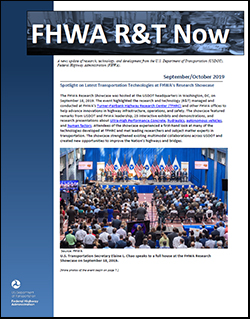
PDF files can be viewed with the Acrobat® Reader®
In this issue…
The FHWA Research Showcase was hosted at the USDOT headquarters in Washington, DC, on September 18, 2019. The event highlighted the research and technology (R&T) managed and conducted at FHWA's Turner-Fairbank Highway Research Center (TFHRC) and other FHWA offices to help advance innovations in highway infrastructure, operations, and safety. The showcase featured remarks from USDOT and FHWA leadership, 25 interactive exhibits and demonstrations, and research presentations about Ultra-High Performance Concrete, hydraulics, autonomous vehicles, and human factors. Attendees of the showcase experienced a first-hand look at many of the technologies developed at TFHRC and met leading researchers and subject matter experts in transportation. The showcase strengthened existing multimodal collaborations across USDOT and created new opportunities to improve the Nation's highways and bridges.
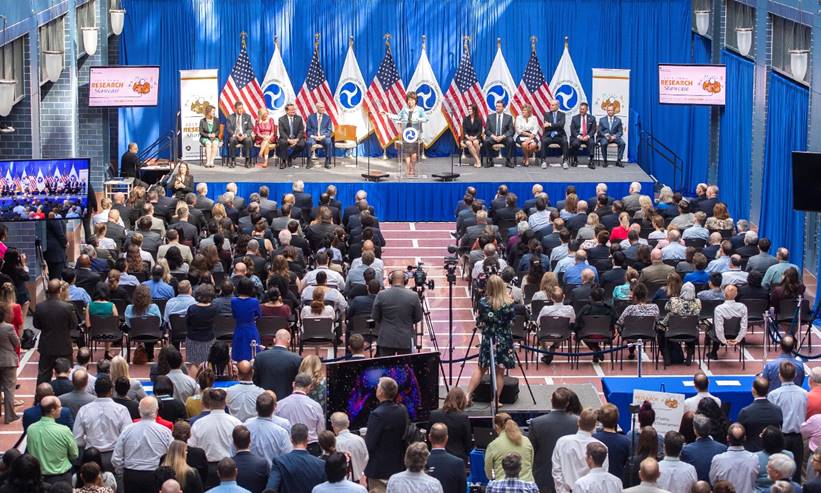
Source: FHWA
U.S. Transportation Secretary Elaine L. Chao speaks to a full house at the FHWA Research Showcase on September 18, 2019.
(See more photos from the event.)
Imagine a virtual world on the Web that mimics the real world and enables an engineer to test out new tools to help diagnose and address problems affecting actual bridges and their components.
With assistance and funding from FHWA's Exploratory Advanced Research (EAR) Program, researchers at Drexel, Rutgers, and Saint Joseph's Universities are developing an online laboratory where inspectors and engineers can try out diagnostic tools and emerging technologies to examine the condition of virtual bridges. The virtual bridges are "digital twins" of real-world bridges with the same problems or conditions as their real-world counterparts.
"The tools and scenarios presented on the website will help inspectors develop a more comprehensive understanding of a bridge's condition," said Hoda Azari, program manager at FHWA's NDE Laboratory with the Office of Infrastructure Research and Development (R&D).
The virtual NDE laboratory includes data from the real-world bridges and controlled specimens of structural elements and technology used to assess bridge conditions.
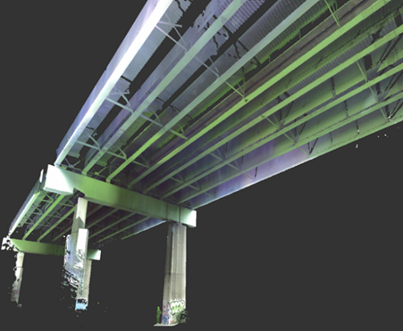
© Rutgers University Department of Civil and Environmental Engineering
In the virtual NDE laboratory, this "digital twin" of a bridge is used to augment the understanding of the bridge's condition from a traditional real-world inspection.
"Using this website will complement the visual inspections already being made by bridge inspectors," said Azari.
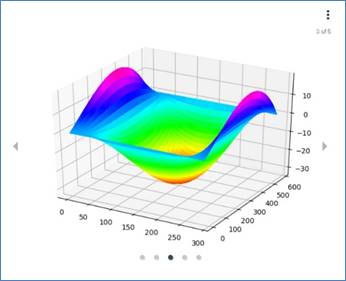
© Drexel University
A simulation of a multiple-reference impact test in which sensor placement and performance impacts are indicated on a virtual bridge. This technique can obtain reliable spatial modal response data with limited onsite instrumentation and operation.
The researchers plan to develop case studies or scenarios aimed at showing laboratory users how physical or nondestructive testing methods can help develop a clearer picture of a bridge's health. The case studies could be used to illustrate best practice applications of various technologies and their integration; demonstrate how well-designed and executed technology applications can lead to generalizable conclusions about bridge performance; and present potential business cases for the application of assessment technologies for bridges.
For more information, see the Virtual Nondestructive Evaluation Laboratory for Highway Structures fact sheet or contact Hoda Azari at 202–493–3064 or Hoda.Azari@dot.gov.
FHWA's EAR Program recently awarded research funding for 11 new projects. The projects represent breakthrough research in four areas: mobile ad hoc networks (MANETs), computer vision, realistic artificial data for vehicle safety, and supplementary materials for highway pavements and structures.
The two MANETs awards went to the University of Virginia and to the University of Wisconsin-Madison. The research could result in new approaches for traffic and pedestrian safety in areas where there is limited connected vehicle infrastructure or during events when connected systems might be overwhelmed.
The EAR Program also funded three awards in computer vision research to develop tools to analyze data available from more than a million hours of driver behavior video image data captured from in-vehicle cameras. One award went to researchers at Iowa State University who are developing intelligent driver state estimation algorithms. Another award went to the University of Michigan, where researchers are using automated video processing algorithms to detect and classify high-level behaviors with speed and accuracy. The third award went to Virginia Tech, which will support researchers applying machine-learning techniques to analyze driver videos and automatically produce annotations and descriptors for events, behavior, and driving scenarios that relate to transportation safety.
Two projects awarded to the University of Connecticut and the University of Missouri address realistic artificial data for vehicle safety. The researchers on these projects are creating simulated crashes that seem realistic and allow for testing of safety countermeasures. If successful, the research will result in a dramatic increase in the effectiveness of countermeasure design.
In the area of supplementary or alternative materials, three awards are focusing on different aspects of supplementary cementitious materials that could provide State DOTs with more reliable options of materials when designing and building roadways and structures. Awards went to Purdue University to examine the use of nontraditional and natural pozzolan-based materials or inorganic polymers; Oklahoma State University to develop classification methods for reclaimed fly ash; and the University of California, Los Angeles, to use machine learning methods to predict and optimize the performance of fly ash-containing binders in concrete.
A fourth award in this category went to researchers at Auburn University, who are focusing on reducing the aging of asphalt binders so roadways last longer.
The EAR Program addresses the need for longer term, higher risk research with the potential for transformative improvements to transportation systems and seeks to leverage advantages in science and engineering that could lead to breakthroughs for critical, current, and emerging issues in highway transportation.
For more information, contact David Kuehn, 202–493–3414, David.Kuehn@dot.gov.
Representatives from the FHWA Long-Term Pavement Performance (LTPP) Program visited the New Mexico SPS-10 [Specific Pavement Study] test site from June 24 to June 27, 2019, to inspect the installation and calibration of a new weigh-in-motion (WIM) system for the collection of high-quality traffic data. A WIM system is used to collect and monitor vehicle classifications, vehicle weights, and axle loads on roadways as vehicles pass over the measurement area. The test site, located on I–40 approximately 80 miles east of Albuquerque, is one of the LTPP Program's warm-mix asphalt (WMA) test sites. The type of WIM system installed on the SPS–10 test site is a quartz sensor that provides the LTPP program with quality traffic data that can be used in pavement design and other traffic applications.
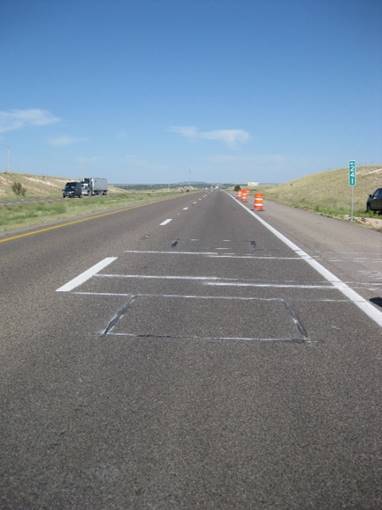
Source: FHWA
The WIM system installed in WMA pavement on I-40 in New Mexico.
Deborah Walker, Highway Research Engineer at TFHRC, was onsite to oversee the contractor preparing the site to install the inroad sensors.
The visit lasted four days, each day focusing on a different aspect of the installation:
There are five, 500-foot test sections at the New Mexico site. Three of the test sections are core sections specifically for the LTPP program. Two supplemental sections contain certain asphalt mixes that New Mexico transportation officials will monitor for their own projects.
This New Mexico SPS-10 site, and the other nine warm-mix sites monitored by the LTPP program, will enable researchers to observe how well the mixes perform in the field over 5-plus years. Distress, smoothness, and structural strength data are collected and stored in LTPP InfoPave™ for States and other transportation agencies to use.
The installation of the New Mexico SPS-10 work supports the LTPP program's WMA study experiment. The program collects pavement performance data, and the traffic data will provide insight on how loading impacts the performance of the different types of WMA mixtures.
For more information, contact Deborah Walker, 202–493–3068, Deborah.Walker@dot.gov.
One of the challenges with CV is for vehicles to examine all aspects of their surrounding environment so that they recognize an important operational or environmental clue (for example, when a vehicle is going slower or faster than a set parameter) and so the vehicle can accurately communicate that information through Basic Safety Messages (BSMs) to other vehicles. BSMs contain important vehicle data, including vehicle positioning, speed, acceleration, and brake status.
When a vehicle does not recognize and communicate the information as expected, the vehicle is categorized as "misbehaving." "Misbehavior" is defined as any instance in which BSMs contain information that do not represent the vehicle's true behavior.
The Office of Operations R&D and the Intelligent Transportation Systems Joint Program Office conducted a 3-day Misbehavior Detection Test from August 12 through August 14, 2019, at TFHRC.
The testing, the first live Misbehavior Detection Test, examined the misbehavior detection algorithm for detecting erroneous BSMs as part of a connected vehicle's (CV's) Security Credential Management System (SCMS).
The success of the CV Pilot program relies on the transmission of BSMs between vehicles and infrastructure.
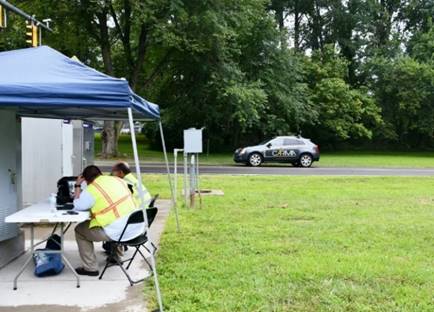
Source: FHWA
Operators conduct misbehavior testing at FHWA's TFHRC.
Operators drove 4 equipped vehicles around the TFHRC facility in a series of 25 short test runs that lasted about 5 minutes each. Researchers sought to identify misbehavior and to ensure that acceptable and accurate messages were not relayed to a misbehavior authority, which could consist of a government entity or a commercial vendor of security certificates. Three types of tests were conducted:
When misbehavior is detected, the SCMS revokes certificates and prevents the system from acting on incorrect data.
The next phases of testing include tests with more stakeholders participating to ensure successful deployment of the algorithm over a wide range of devices and vendors. A second round of testing has been scheduled this autumn.
State departments of transportation (DOTs) and other transportation agencies may be able to use the algorithm presented during the misbehavior testing to ensure the robust deployment of Intelligent Transportation Systems and the wireless exchange of messages between vehicles and infrastructure. The testing will also give State DOTs insight on how to safeguard the systems from malicious use by hackers.
For more information, contact Deborah Curtis, 202–493–3267, Deborah.Curtis@dot.gov.
Motorcycle crashes account for more than 14 percent of all traffic fatalities in the United States, despite representing less than 1 percent of vehicle miles traveled on America's roads.
To examine motorcycle crashes, FHWA conducted the Motorcycle Crash Causation Study (MCCS). The MCCS used a crash-and-control case approach developed from OECD protocols [Organisation for Economic Co-operation and Development] and collected more than 1,900 data elements associated with the causes of motorcycle crashes. The study produced a final report and 14 volumes of documentation.
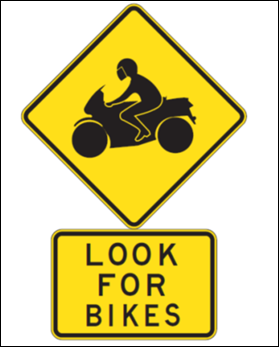
Source: FHWA
An example of a sign used to increase motorcycle awareness.
In 2018, FHWA initiated the Infrastructure-Based Motorcycle Crash Countermeasures Phase I project. This study analyzed the MCCS database, conducted a comprehensive literature review, and held a motorcycle stakeholder workshop. That project led FHWA to develop infrastructure-based motorcycle crash countermeasures, of which five will be evaluated in New/Novel Highway Signs to Support Infrastructure-based Motorcycle Crash Countermeasures:
Goals of the new study include:
To test sign comprehension, researchers will ask participants—consisting of motorcycle riders and nonriders—to look at an image of a sign they might encounter on the roadway. Participants will be asked to describe the meaning of the sign, the sign's intended audience, and then asked to rate how effectively the sign conveys the intended meaning.
To test sign legibility, signs will be shown to the participants on a computer screen. The sign will first appear small before increasing in size. Participants will press a button on the table in front of them as soon as the sign becomes legible. When the button is pressed, the sign will disappear and participants will describe the sign out loud.
FHWA will partner with interested State DOTs to implement highway signs from the prioritized list on a variety of roadway facilities such as interstates, State roads, local roads, and highways in national parks. These highway signs will be evaluated to determine their effectiveness in decreasing motorcycle crashes on the Nation's highways.
For more information, contact Yusuf Mohamedshah, 202–493–3464, Yusuf.Mohamedshah@dot.gov.
In 2018, 6,283 pedestrians were killed in traffic crashes.(1) One cause of fatal crashes may be the inability of vehicle drivers to see pedestrians in the surrounding environment.
The Office of Safety R&D began a new research project on light-emitting diode- (LED)-embedded pedestrian signs to increase the awareness of pedestrians present in the area. The project, Safety Study on Pedestrian Activated Beacons Crossing Signs, will assess the effectiveness of LEDs in sign faces and determine if LEDs improve safety at intersections by enhancing driver awareness of traffic-control signs.
(1) Webb, Caitlin N. September 2019. "Traffic Safety Facts Research Note. Geographic Summary of Pedestrian Traffic Fatalities." U.S. Department of Transportation. National Highway Traffic Safety Administration. Washington, DC. Available at https://crashstats.nhtsa.dot.gov/Api/Public/ViewPublication/812822.
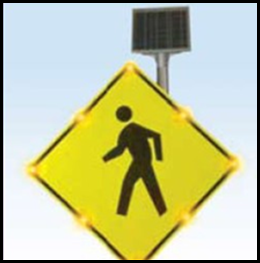
Source: FHWA
An example of a pedestrian crossing warning sign with embedded LEDs and a solar unit.
LEDs can be embedded in standard highway warning and regulatory signs to outline either the sign itself or the words and symbols on the sign. The LEDs may be set to flash or operate in steady mode. LEDs can be illuminated 24 hours a day, or be activated by vehicles traveling over sensors installed in the roadway, or by pedestrians pushing a button on the side of the road.
Locations where LED-embedded signs can be implemented include:
Two benefits of using LED-embedded pedestrian signs include:
Upon completion of the project and publication of a research report, State transportation agencies will be able to discern whether using LED-enabled pedestrian signs will be beneficial for their needs.
For more information, contact Ann Do, 202–493–3319, Ann.Do@dot.gov.
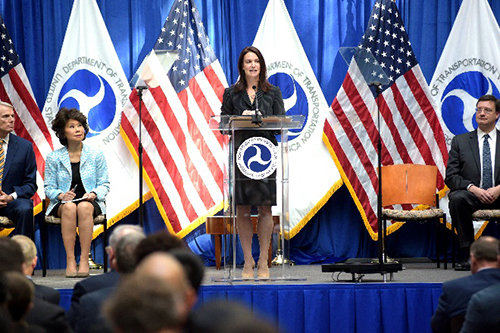
Source: FHWA
FHWA Administrator Nicole R. Nason speaks to the attendees of the FHWA Research Showcase.
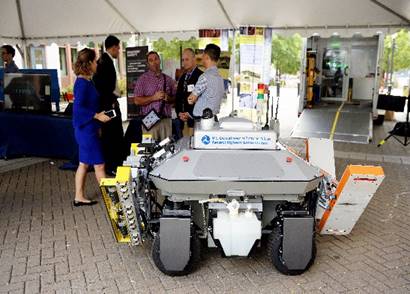
Source: FHWA
The RABIT™ bridge deck assessment tool on display at FHWA Research Day.
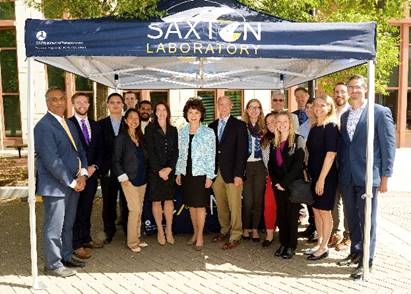
Source: FHWA
Members of TFHRC's Saxton Transportation Operations Laboratory stand with USDOT Secretary Elaine L. Chao and FHWA Administrator Nicole R. Nason.
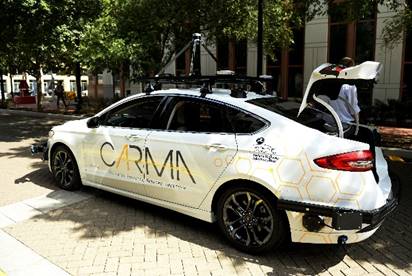
Source: FHWA
CARMASM vehicle on display on the 3rd Street Plaza outside USDOT headquarters.
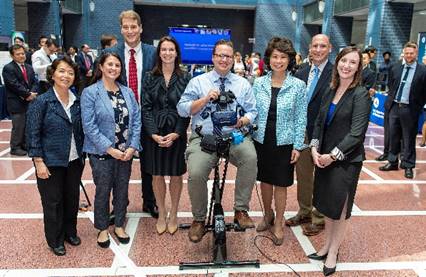
Source: FHWA
USDOT Secretary Chao and FHWA Administrator Nason stand with members of the Safety R&D team as the bicycle simulator and virtual reality headset are displayed.
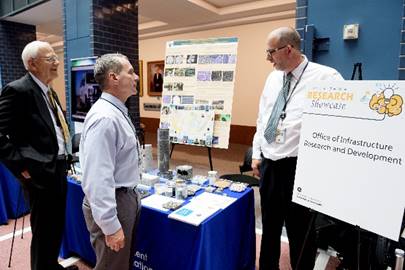
Source: FHWA
Attendees of the Research Showcase discuss and examine a variety of pavement materials.
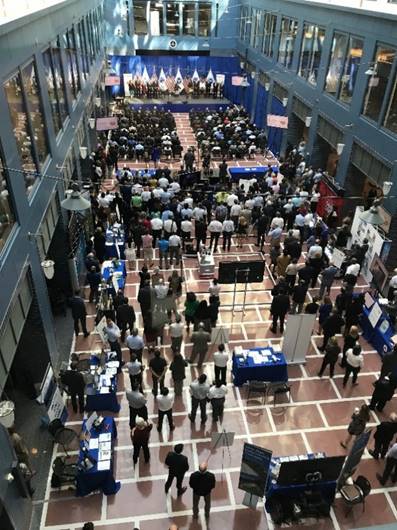
Source: FHWA
Attendees of the Research Showcase listen to speakers on the main stage and browse exhibit tables on each side and in the middle of the hall.
Articles include: Moving FoRRRwD to Reduce Rural Roadway Departures; States STEP Up to Enhance Pedestrian Safety; Using Data to Improve Traffic Incident Management; States Make Innovation Everyday Practice; EDC-r Success Stories; Bridge Bundling Guidebook Available; States Innovate!; Learn About New Innovations
The issue is available online.
For more information, contact Nichole Causey, Nichole.Causey@dot.gov.
Please forward this newsletter to others you think might find it interesting and/or useful.
Suggestions may be submitted to FHWA_Now@fhwa.dot.gov.
FHWA R&T Now is a newsletter containing information and updates about research, technology, and development from the U.S. Department of Transportation, Federal Highway Administration. The newsletter is an electronic newsletter and is updated approximately every other month.
Send your comments, questions, and feedback to FHWA_Now@dot.gov.
Online access:
https://www.fhwa.dot.gov/publications/rtnow/.
Mail:
Federal Highway Administration
FHWA Office of Research, Development, and Technology
Attention: R&T Now Managing Editor
6300 Georgetown Pike
McLean, VA 22101
| BSM | Basic Safety Messages |
|---|---|
| CV | Connected Vehicle |
| DOT | Department of Transportation |
| EAR | Exploratory Advanced Research |
| FHWA | Federal Highway Administration |
| LED | Light-emitting Diode |
| LTPP | Long-Term Pavement Performance |
| MANET | Mobile Ad Hoc Networks |
| MCCS | Motorcycle Crash Causation Study |
| NDE | Nondestructive Evaluation |
| OECD | Organisation for Economic Co-operation and Development |
| R&D | Research and Development |
| R&T | Research and Technology |
| RD&T | Research, Development, and Technology |
| SCMS | Security Credential Management System |
| TFHRC | Turner-Fairbank Highway Research Center |
| USDOT | United States Department of Transportation |
| WIM | Weigh-in-Motion |
| WMA | Warm-Mix Asphalt |
Distribution–FHWA R&T Now is being distributed according to a standard distribution. Direct distribution is being made to the FHWA Divisions and Resource Center.
Key Words–LTBP, bridges, safety, infrastructure, operations, bicycles, bicyclists, separated bike lanes, connected and automated vehicles, intelligent transportation systems, concrete, ultra-high performance concrete, research.
Notice–This document is disseminated under the sponsorship of the U.S. Department of Transportation in the interest of information exchange. The U.S. Government assumes no liability for the use of the information contained in this document. The U.S. Government does not endorse products or manufacturers. Trademarks or manufacturers' names appear in this document only because they are considered essential to the objective of the document.